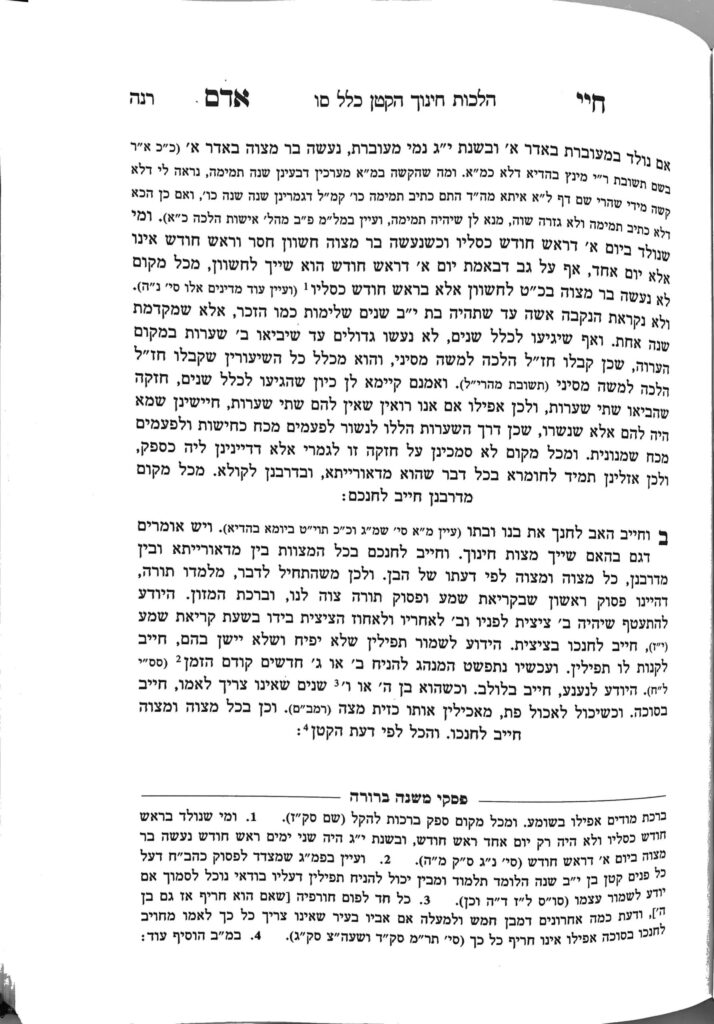We are continuing in siman 1. The Chayei Adam is discussing a child born in the month of Adar, and how to calculate his bar mitzvah. We have learned that the “real” Adar, for the purposes of calculating bar mitzvah, is the second Adar. Therefore, if a child is born in a regular year, and their bar mitzvah is in a leap year, their bar mitzvah is calculated to the second adar.
There is an opinion of an earlier acharon, the Maharash Halevi, that the first Adar is the “real” Adar regarding calculating bar mitzvah. The Mishnah Berurah does not even quote this opinion. The Shaarei Teshuva does quote it, but writes that there are multiple teshuvos against the Maharash Halevi, and points out that the Rema and Shulchan Aruch explicitly state to follow the first Adar. However, some are machmir to follow the Maharash Halevi lechumrah; meaning, the bar mitzvah boy will have to keep issurim and chiyuvim as a gadol (e.g., tefillin, fasting), but does not have the privileges of a gadol (e.g., not counted for minyan, cannot lain, etc.).
In the parentheses, the Chayei Adam disagrees with the opinion of the Magen Avraham, as we learned previously (shiur 1265). The Magen Avraham holds that if a child is born in the first Adar of a leap year, and the year of his bar mitzvah is a leap year, his bar mitzvah is calculated to the second Adar. The Chayei Adam disagrees, and holds that it is calculated to the first Adar, as is the consensus of the poskim.
The Chayei Adam next discusses the months of our calendar which do not have a fixed number of days. These are the months of Cheshvan and Kislev, which can each be either 29 or 30 days, depending on the year. Other than these two months, all other months follow an alternating pattern between 29 and 30 days, beginning with Nissan, which has 30 days. Thus, Nissan has 30 days, Iyar has 29; Sivan has 30 days, Tamuz has 29, and so on.
When Cheshvan and Kislev follow the pattern of the other months, such that Cheshvan has 29 days and Kislev has 30 days, the year is known as a shanah kesidran. If Cheshvan and Kislev both have 29 days, the year is known as a shanah chaseir. If Cheshvan and Kislev both have 30 days, the year is known as a shanah shaleim.
The number of days in Cheshvan and Kislev can create an issue in calculating bar mitzvah: if a child is born on the 30th of Cheshvan or Kislev, in the year of his bar mitzvah that day may not exist.
Two days of Rosh Chodesh are only kept when the previous month had 30 days, such that the two days of Rosh Chodesh fall out on the 30th of the previous month and the 1st of the new month.
If a child is born on the last day of either of these months, the argument could be made that since he was born on the last day of the month, his bar mitzvah should be calculated to the last day of the month as well–even if there are only 29 days in the year of his bar mitzvah. Nevertheless, we pasken that he becomes bar mitzvah on the first day of the next month; i.e., on Rosh Chodesh.
Summary
- If a child is born in a regular year, and their bar mitzvah is in a leap year, their bar mitzvah is calculated to the second Adar.
- There is an opinion that the bar mitzvah should be calculated to the first Adar. Some follow this opinion lechumrah.
- If a child is born in the first Adar of a leap year, and the year of his bar mitzvah is a leap year, his bar mitzvah is calculated to the first Adar.
- If a child is born on the 30th of Cheshvan or Kislev, and in the year of their bar mitzvah the date does not exist, their bar mitzvah is calculated to the first day of the next month.



